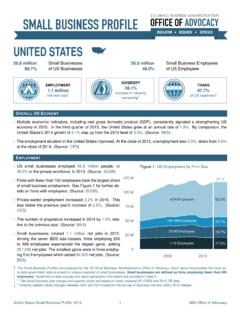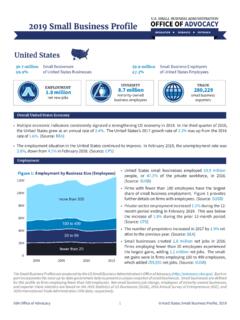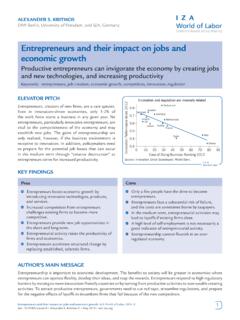Transcription of SMALL BUSINESSES, JOB CREATION AND GROWTH: FACTS ...
1 1 SMALL businesses , JOB CREATION AND growth : FACTS , OBSTACLES AND BEST PRACTICES2 Table of contentsExecutive 1. Job CREATION , Output and Productivity 2. Financing SMALL and Medium 3. SMEs and Regulatory 4. Public Support to 5. Innovative 6. High growth 7. Women-owned 8. The Regional Dimension to 9. Best Practice Policies for SUMMARYThe importance of SMEsSMEs ( SMALL and medium-sized enterprises) account for 60 to 70 per cent of jobs in most OECD countries, with a particularly large share in Italy and Japan, and a relatively smaller share in the UnitedStates. Throughout they also account for a disproportionately large share of new jobs, especially in thosecountries which have displayed a strong employment record, including the United States and theNetherlands.
2 Some evidence points also to the importance of age, rather than size, in job CREATION : youngfirms generate more than their share of employment. However, less than one-half of start-ups survive formore than five years and only a fraction develop into the high- growth firms which make importantcontributions to job CREATION . High job turnover poses problems for employment security; and smallestablishments are often exempt from giving notice to their employees. SMALL firms also tend to investless in training and rely relatively more on external recruitment for raising demand for reliable, relevant and internationally comparable data on SMEs is on the rise, andstatistical offices have started to expand their collection and publication of data. Internationalcomparability is still weak, however, due to divergent size-class definitions and sector classifications.
3 Toenable useful policy analysis, OECD governments need to improve their build-up of data, without creatingadditional obstacles for firms through the burden of excessive paper confronted by SMEsThe greater variance in profitability, survival and growth of SMEs compared to larger firmsaccounts for special problems in financing. SMEs generally tend to be confronted with higher interestrates, as well as credit rationing due to shortage of collateral. The issues that arise in financing differconsiderably between existing and new firms, as well as between those which grow slowly and those thatgrow rapidly. The expansion of private equity markets, including informal markets, has greatly improvedthe access to venture capital for start-ups and SMEs, but considerable differences remain among burdens remain a major obstacle for SMEs as these firms tend to be poorly equippedto deal with the problems arising from regulations.
4 Access to information about regulations should bemade available to SMEs at minimum cost. Policy makers must ensure that the compliance proceduresassociated with, R&D and new technologies, are not unnecessarily costly, complex or is of particular importance to SMEs, and information technology has great potential tonarrow the information gap. It would be of great help to set up a one-stop-shop system , where all thenecessary information which affects firm strategies and decisions is made available in one place, as existsalready in some for SMEsMost OECD countries have programmes which support SMEs. One-quarter of all public supportprogrammes reported to the OECD primarily target SMEs. Germany, Iceland, Japan and New Zealanddedicated more than 50 per cent of their entire public support programmes to SMEs.
5 In 1993, a total ofUS$ billion of public money was paid to help start-ups, the acquisition of equipment, R&D, trainingand consultancy services, in the form of direct grants, tax concessions, low interest rate loans or loanguarantees. More than 50 per cent of SME programmes are administered locally, making co-ordinationbetween authorities critical. There is potential for integrating programmes into fewer schemes but with awider scope, making it easier for SMEs to understand them, and lowering administrative costs. Almost 70per cent of SME programmes last for more than five years. Stable and predictable programmemanagement is in the interest of users; however, a constant review process is vital to ensure quality andflexibility. Governments need to intensify their efforts to disseminate information, eliminate unnecessaryred tape, and make programmes more responsive to the changing needs of 30 and 60 per cent of SMEs can be characterised as innovative, of which some 10 percent are technology-based.
6 Innovative SMEs tend to be market-driven rather than research-driven, andquicker in responding to new opportunities than large firms. They play a key role in pioneering anddeveloping new markets. Programmes for improving the diffusion of technology have shifted from asupply focus to raising the capacity of SMEs to absorb technology. However, governments need to: reduceuncertainties in the tax, regulatory and macroeconomic environment; make sure that business frameworkconditions do not impact unfavourably on the risk/reward ratio; and encourage the mobility of humanresources and the markets for specialised services. Although these are important for the entire economy,such actions will produce benefits of particular value to successesA limited number of so-called high- growth SMEs make important contributions to job CREATION andproductivity growth in the OECD area.
7 At the earlier stages, management capabilities are crucial tosurvival. As the firm matures, human resource and innovation strategies increase in importance. By thetime the firm has become established, innovation is crucial for growth . The fastest growing entrants arethose that translate strategy into action in the form of R&D, innovation and training, put great emphasis onhiring skilled employees and motivating employees, and balance the enhancement of their capabilities indifferent areas -- the last being particularly important in high-knowledge sectors. The main barriers to thedevelopment of high- growth SMEs are market failures in capital markets, government regulations,indirect labour costs, access to foreign markets, and difficulties in recruiting qualified staff and SMEs are growing at a faster rate than the economy as a whole in several OECD countries,allowing capitalisation of the skills of educated and trained women who might otherwise be blocked incorporate advancement because of the glass ceiling.
8 The increased flexibility inherent in owning one sbusiness allows women to contribute to the income of their families while balancing work and familyresponsibilities. However, the economic potential of women entrepreneurs remains partly untapped;measures are required to improve information and statistics in this field, as well as to strengthen thepreconditions for financing, networks and tends to vary markedly across regions. An increasing number of regions are known forgenerating clusters of dynamic firms which benefit from information spill-over and other intangiblefactors. Regional development policies have been introduced to assist regions suffering from declining5industries. The primary policy tools for attracting firms to disadvantaged regions are investment ininfrastructure, social assistance, training and other forms of public assistance.
9 The regional dimension ofentrepreneurship is not limited to clusters of enterprises but also includes micro enterprises. Programmesto assist the CREATION and development of micro enterprises in inner cities and remote rural areas havebecome widespread policy tools. Governments wishing to adopt policies used successfully in otherregions or countries should take the regional context into practice policiesThe report ends with lessons from policies undertaken in five areas:--FinancingThe primary role of the public sector in supporting venture capital is to reduce the risk and costof private equity finance, complementing and encouraging the development of the private capitalindustry. There is major variation across OECD countries in the use of funding methods forSMEs, but the provision of equity financing to start-up companies is more advanced in theUnited States and Canada than elsewhere.
10 Taxation should not impose a disproportionatelyheavy burden on business environmentThis can be improved by systematic and careful scrutiny of new regulations and byimplementation of a business impact system to ensure the audit and monitoring of newlegislation. Canada, the United Kingdom and the Netherlands have successfully introducedprocedures to that end. The use of information technologies provides opportunities for reducingbureaucratic burdens on all companies, including diffusion programmes should: ensure quality control; promote customer-orientation; upgrade the innovative capacity of firms -- including the promotion of generalawareness of the value of innovation among management -- and stimulate demand for technicaland organisational change; build on existing inter-relationships in national innovation systemsand provide greater coherence between programme design ( targets, objectives, modes ofsupport) and service delivery; build on evaluation and assessment.
















